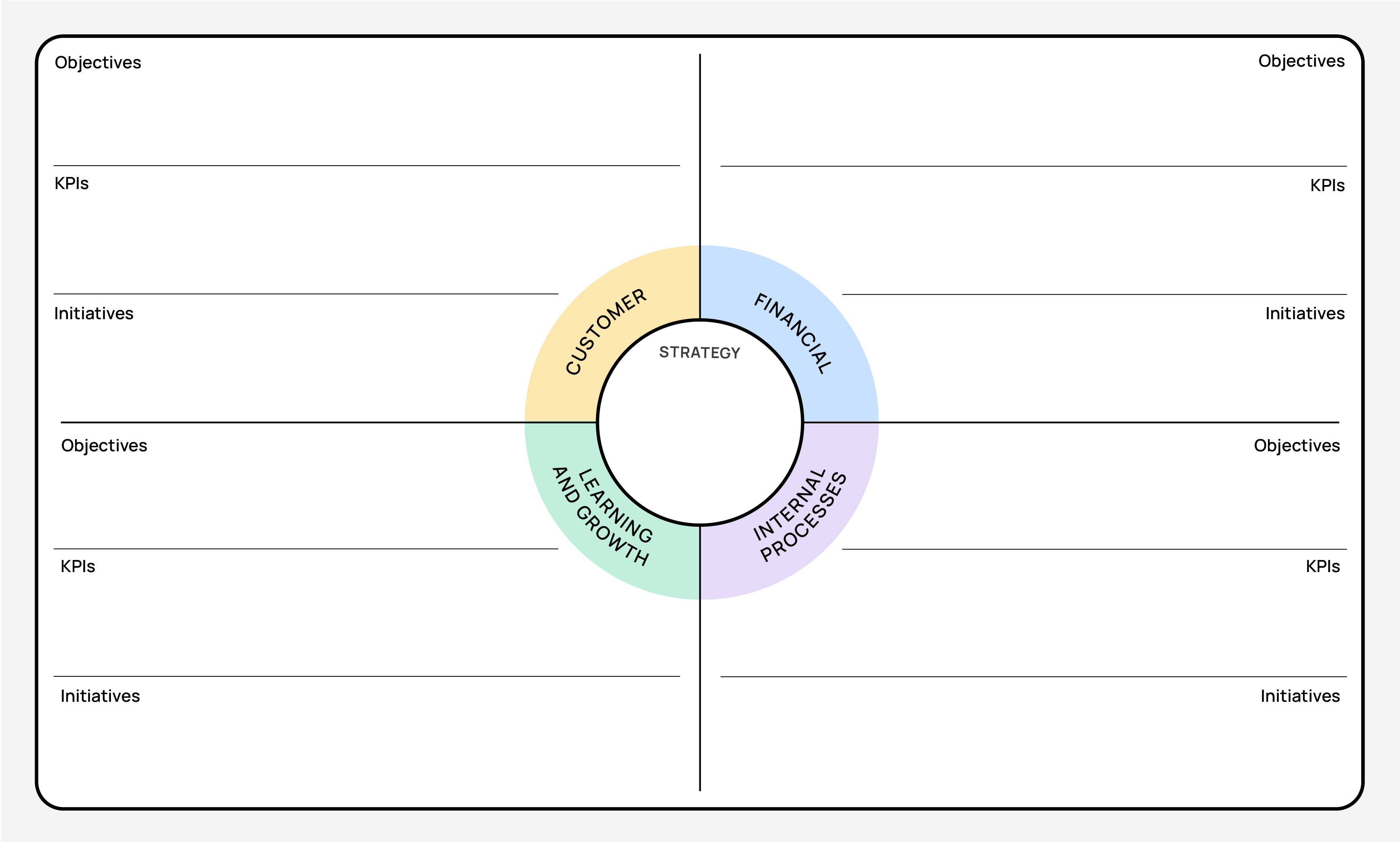Balanced Scorecard
The balanced scorecard is a report card for an organisation. It doesn’t just look at how much money the company is making, but also at other important things like how happy the customers are, how well the company’s processes are working, and how much the company is growing and improving. It gives a more complete picture of how the organisation is doing overall, and can be used to improve performance.
Key concepts important in generating a Balanced Scorecard:
Financial Perspective: How well the organisation is doing financially and if it’s making money
Customer Perspective: How happy customers are with the organisations products or services
Internal Processes Perspective: How well things are running inside the organisation
Learning and Growth Perspective: How much the organisation is improving and learning to be better in the future
The results
- Improved alignment of objectives to strategy
- Increased accountability
- Comprehensive performance data

When to use it
Strategy Formulation: When aligning objectives with an overarching mission and vision
Performance Improvement: When tracking, measuring and identifying improvements for different areas across an organisation
Decision Making: When looking to make decisions based on performance indicators
Strengths
Holistic
Aligns objectives to strategy
Versatile across industries
Weaknesses
Can be complex
Resource intensive
How to use it?
What do I need to start?
Various inputs that can be used for analysis:
- Financial metrics e.g. revenue, profitability, cost structures
- Customer-related metrics e.g. satisfaction, market share, retention rates
- Internal performance metrics e.g. process efficiency, utilisation rates
- Learning and growth metrics e.g. employee turnover, satisfaction surveys
How to use it?
Who to involve?
- Representatives responsible for implementing strategic plans
- People who understand related challenges
Step by step
1
Review the strategy
Ensure everyone involved in developing the balanced scorecard understands the organisations strategy
2
Collect and analyse inputs
Collect relevant inputs for each category. For each category, identify important insights, such as:
- Areas of the organisation performing well
- Areas of the organisation that could be improved
- Blindspots in each category where there are limited metrics
3
Define organisational objectives
Brainstorm objectives that relate to each of the four perspectives. A simple and effective format is Smart Goals.
Questions to prompt thinking include:
Financial
- How can we increase revenue and profitability?
- What cost reduction approaches can we implement?
Customer
- What are our customers’ needs and expectations?
- What new markets or customer segments could be targeted?
Internal Processes
- Which processes can be streamlined or improved?
- How can we improve the quality of products or services?
Learning and Growth
- What skills do our employees need to develop?
- How can we foster a culture of innovation?
Choose one or two important objectives in each of the perspectives.
4
Develop performance indicators
Brainstorm performance indicators for each perspective.
Consider the potential impacts, positive and negative, of introducing each indicator. Ask questions like:
- Is it easy to measure?
- What behaviours might it encourage or discourage?
- Does it show us what’s happened in the past or what is likely to happen in the future?
Choose one or two important indicators for each of the perspectives.
5
Benchmark performance and set KPI targets
Benchmark current performance by measuring each of the agreed indicators.
Consider current capacity and appetite to deliver change that may lead to improved performance.
Brainstorm targets for each indicator, including a performance outcome and timeframe to achieve the outcome. Ask questions like:
- How realistic is each target given current performance?
- How realistic is it to work on all of these targets at the same time?
- Can the outcomes timeframes be phased to make the targets more feasible?
- What would be the impact is targets are not met?
- How much effort is involved in monitoring and reporting on all of these targets?
Choose one or two important targets to focus on for each perspective.
Define who is responsible for each target, and how they will measure and report on each target.
6
Define initiatives
Consider what work is required to achieve the objectives.
Agree on key initiatives. For each initiative, define:
- Who is responsible for delivery
- Indicative start and end dates
- Resources required
Consider doing a Project Initiation Document (PID) for each initiative.
7
Communicate
Organise the agreed objectives, KPIs and initiatives into a balanced scorecard canvas.
Communicate objectives and KPIs throughout the organisation.
8
Performance evaluation and adjustment
Monitor progress of KPIs.
Assess how well the organisation is meeting objectives.
Consider if any initiatives need reviewing.